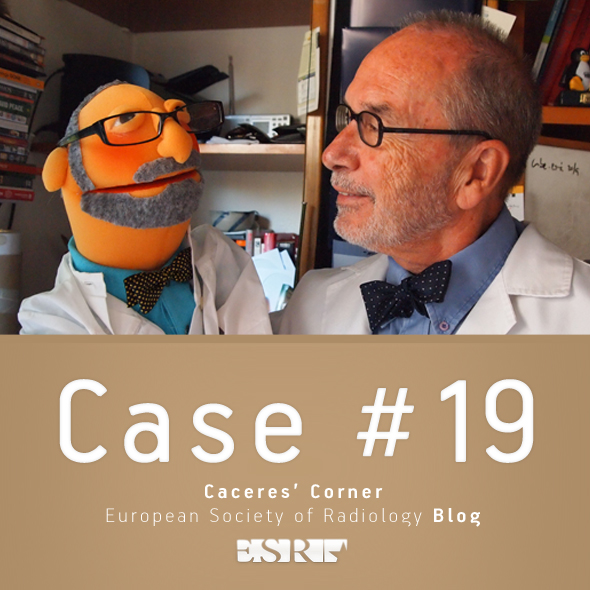
Dear Friends,
Muppet wants to test your diagnostic skills with the following case:
75-year-old male with vague pain in the right hemithorax.
Diagnosis:
1. Myeloma
2. Hydatid cyst
3. Fibrous dysplasia
4. None of the above
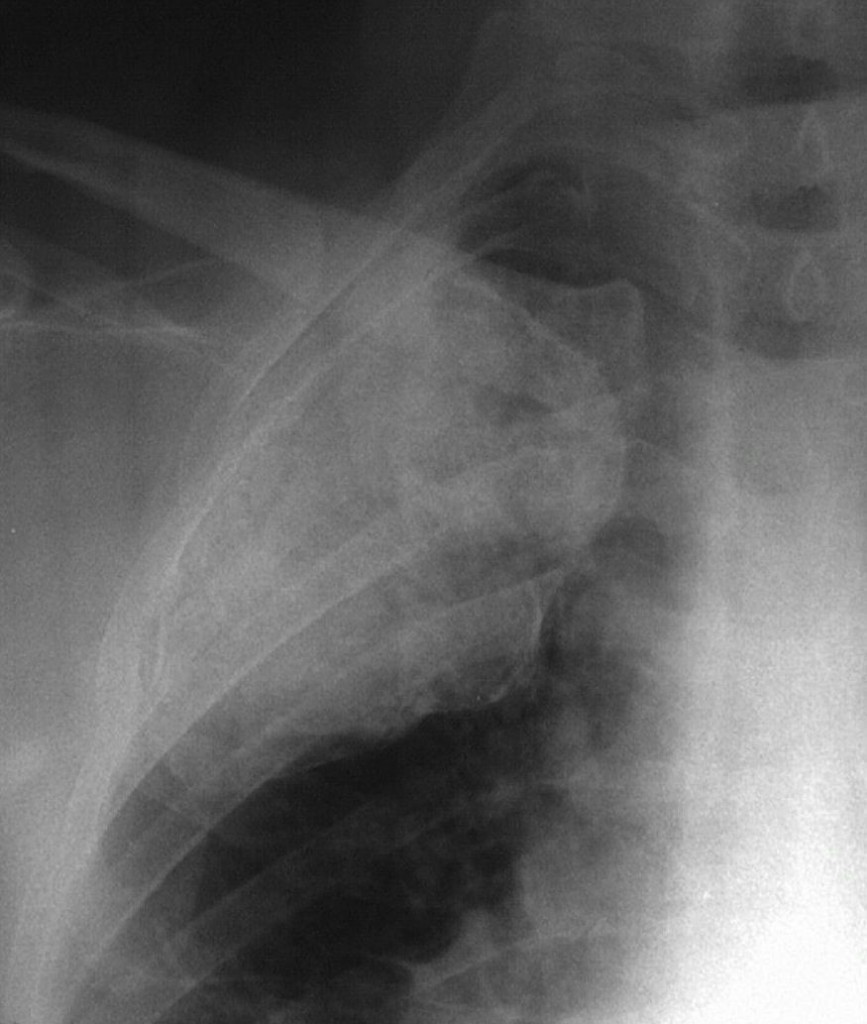
75-year-old male, PA chest
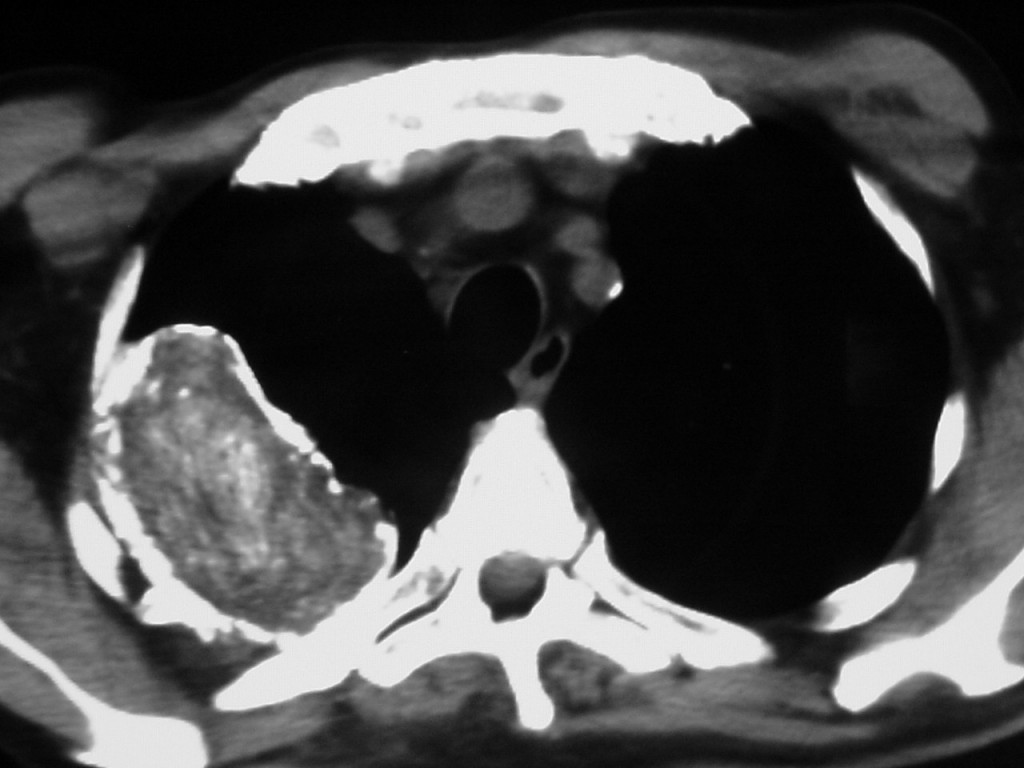
75-year-old male, CT
Click here for the answer to case #19
The PA chest film shows an irregular mass with calcified borders in the upper lung field. The posterior arch of the 4th rib is missing. CT shows a mass with coarse peripheral calcification (arrows).
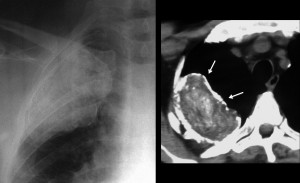
The inside of the mass has a weird appearance with whorls of calcification and areas of decreased opacity. The CT appearance is practically pathognomonic of oleothorax (plombage).
Instillation of oil in the extrapleural space (oleothorax) was used to collapse the lungs facilitating healing of TB cavities. This method was abandoned in the early fifties after the discovery of effective antimicrobial therapy.
Patients with oleothorax are still seen and it is important to recognize the imaging findings to avoid misdiagnosis. All of them have the same appearance: extrapulmonary mass in the upper chest with absence of the 4th-5th rib (removed to instill the oil). The calcification and the whorly appearance of the mass are nearly pathognomonic. Fig. 2 shows three more cases, one of them seen two years ago.
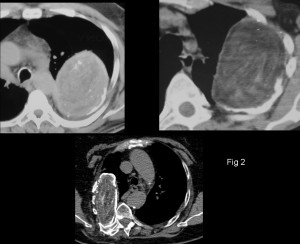
Teaching point: when confronted with a weird image, always remember to ask the patient for a previous surgical procedure. If he/she does not remember, look for a surgical scar.







The CT image suggest polyostotic form of fibrous dysplasia as there is expanded marrow lesion, ground glass type of appearance due to fibrous tisse in the marrow cavity with high attenuation in between,may be due to embaded bony fragments or calcifications.well deliniated sclerotic margins are present. This is not Multiple Myeloma as there is no multiple,well defined intramedullary lytic (punched out)lesion.
That’s a pleural hydatid cyst!
My differential included thinking of extrapleural mass with dense calcification:
1. Osteochondroma ( cuold be in the Rx, rare to grow inside and not convincing condroid matrix on CT).
2. Ancient schwannoma (too many calcifications).
3. Fibrous pleural tumor (too many calcifications).
Even with the markedly low density point inside the lesion could think about fat and then about liposarcoma (also too many calcifications and rare if not prevously treated).
Anyway, the internal structure is absolutely diagnostic for me of HYADTID CYST.
Then, never do the biopsy!!!
Muppet remembers an occasion when he said: “I am absolutely sure…” and he was wrong!
Ok so… I strongly believe…
Hydatid cyst calcified only in the liver!
La radiografia standard mostra una opacità. densa, di tipo calcica, ma disomogenea ed a margini abbastanza definiti, senza lesioni litiche costali. La tc definisce la sede di questa opacità:essa è intrapolmonare e non intra-ossea:dovremo escludere allora il mieloma e la displasia fibrosa.L’espanso dimostra una parete calcifica ed un contenuto ipodenso ma con sfumature calcifiche:esso inoltre esso è voluminoso(questo depone per una lente crescita nel tempo).Inoltre il pazientè anziano.Per tutto questo penso ad una vecchia cisti idatidea calcificata.
There is a white lesion on the upper portion of the right hemithorax in chest radiograph. The edge of the lesion appears also white on CT. Its content is mixed. There are white areas inside and also other with low density. I´m thinking about Mupet is changing to the Real Madrid team beacause the white density dominates the lesion. I´ve thought also about the Mupet´s mixed feelings. He must be looking at the brilliant last years of his team. On the other hand he would be planning the black future without Pep. The white and black aspect of this case must be a symbol the Mupet have choosen to show us his feelings and our answer. None of the answers offered here seems to me nor to much white neither to much black to be correct. Could be Mupet is saying us the correct is 4?
Muppet is a gentleman and will not argue with a lady.
I will go for no. 4. Did he suffer from tuberculosis as a child?
This looks like extrapleural pneumolysis treatment.
Nodular area of mottled, ground-glass matrix, partially containing fat and punctate calcifications, extruding from the inner surface of the posterior arch of 4th right rib, with net, partly calcified contour at the interface with the lung. What bothers me is the slight change in axis at the lateral margin of the lesion -in case the pain installed abruptly i would consider a pathologic fracture.
The most likely diagnosis is (for me) a fibrous dysplasia – typically the most common rib lesion, ground glass matrix
If the surgical past of the patient permits, i could consider based on these images a gossypiboma or some weird pleurodesis, but i don’t see any reason for it here. I don’t think this is: hydatid cyst because there are calcifications of the contour (as far as i know pulmonary / pleural hydatic cyst rarely calcify); plasmocytoma – again too many calcifications, should not contain fat; ecchondroma – the matrix is not chondroid; osteochondroma – too little calcifications. That’s it for me, awaiting the answer.
What about a Pancoast tumor? It´s the tipicall localization and it coincides with the simpthoms
I would not think of Pancoast. Peripheral calcification goas against it. Muppet agrees
What about a Pancoast tumor?
Answer: None of the above.
Fibrous dysasia becomes symptomatic earlier age.
Multiple myeloma multiplicity of the lesion.
Hydatid usually in lower lobes.
This appears to be an old empyema.
Close enough. Answer coming soon
Fibrous Dysplasia
Fibrous dysplasia
multiple myeloma : one would expect a lytic lesion. This one isnt to the extent lytic.
Plamacytoma : again expansile lytic but the matrix and calcifications kind of give it an odd look for considering it as a plasmacytoma.
Fibrous dysplasia: always bizzare lesions in these locations. could likely be it , but where is the rib expansion ? ummm !
hydatid cysts : surely can calcify. they never study a book. i ll put my money on an old hydatid cyst. with close second differnetial of fibrous dysplasia.
MUPPET KNOWS IT , ISNT IT ?
Muppet knows everything!
Tricky, tricky Mr. Muppet, I’m working on it. Surely it is nr 4.
It is…
In the xrays I do see erosion in the lower margin of the thrid rib and can´t see the upper margin of the fourth one. It has the appearance of a solid heterogeneous mass with calcification of the edge. It may be a bone lession like a plasmocitoma (evenwhen they are defined to be lytic lessions, they can present with a big soft tissue mass). On the other hand the rim calcification is often seen in the hydatid cyst, but in this case i don´t clearly see the daughters cysts.
I´ll stick with……..bone lessions… plasmocitoma
Sure it can be an old empyema; but I assumed that’s an assimptomatic or at least subclinical finding…If you had an empyema I think you would remember it… It’s easier to forget that you had a dog when you were young…
The same for gosypiboma… Coul be, but It’s difficult to forget that you had a pleuropulmonary surgery…
When you are 75 and the procedure was performed sixty years ago, yes, you may not remember very well.
Ok then…great mistake…unforgettable lesson.
thank you, fantastic case!!!
La D.D. è tra una vecchia cisti idatidea ( ma con anomala posizione in campo polmonare superiore) ed un gossypiboma( ma ci dovrebbe essere un raccordo anamnestico di intervento chirurgico sul torace).Una analisi più attenta dell’Rx-torace e della TC, fa intravedere esiti di “rimaneggiamento” costale e questo potrebbe deporre per un vecchio intervento chirurgico “Dimenticato” in tutti i sensi: dal paziente e dal chirurgo non attento!!!!
maybe pleural tuberculosis..
Looks like old calcified empyema . Right hemi thorax looks smaller with crowdded ribs and extra osseous extra pulmonary lesion showing extensive calcification
Is that bad thing?